Related Research Articles
Slashdot is a social news website that originally billed itself as "News for Nerds. Stuff that Matters". It features news stories on science, technology, and politics that are submitted and evaluated by site users and editors. Each story has a comments section where users can add online comments.
SourceForge is a web service that offers software consumers a centralized online location to control and manage open-source software projects and research business software. It provides source code repository hosting, bug tracking, mirroring of downloads for load balancing, a wiki for documentation, developer and user mailing lists, user-support forums, user-written reviews and ratings, a news bulletin, micro-blog for publishing project updates, and other features.

LilyPond is a computer program and file format for music engraving. One of LilyPond's major goals is to produce scores that are engraved with traditional layout rules, reflecting the era when scores were engraved by hand.

Sibelius is a scorewriter program developed and released by Sibelius Software Limited. It is the world's largest selling music notation program. Beyond creating, editing and printing music scores, it can also play the music back using sampled or synthesised sounds. It produces printed scores, and can also publish them via the Internet for others to access. Less advanced versions of Sibelius at lower prices have been released, as have various add-ons for the software.
Finale is a proprietary music notation software developed and released by MakeMusic for Microsoft Windows and macOS since 1988.

Braille music is a braille code that allows music to be notated using braille cells so music can be read by visually impaired musicians. The system was incepted by Louis Braille.
SATB is an initialism that describes the scoring of compositions for choirs, and also choirs of instruments. The initials are for the voice types: S for soprano, A for alto, T for tenor and B for bass.

Notepad++ is a free and open-source text and source code editor for use with Microsoft Windows. It supports tabbed editing, which allows working with multiple open files in a single window. The product's name comes from the C postfix increment operator; it is sometimes referred to as npp or NPP.

Denemo is a scorewriter and music sequencer. Denemo has been under development since 1999.

Synthesia is a piano keyboard trainer for Microsoft Windows, iOS, macOS, and Android which allows users to play a MIDI keyboard or use a computer keyboard in time to a MIDI file by following on-screen directions, much in the style of Keyboard Mania or Guitar Hero. Additionally, Synthesia can be paired with MIDI keyboards that have illuminated keys, or with virtual player piano on screen, which some people believe makes learning piano easier for beginners. It was originally named Piano Hero, due to the similarity of gameplay with Guitar Hero; this was until Activision sent a cease and desist to the program's creator, Nicholas Piegdon.
Optical music recognition (OMR) is a field of research that investigates how to computationally read musical notation in documents. The goal of OMR is to teach the computer to read and interpret sheet music and produce a machine-readable version of the written music score. Once captured digitally, the music can be saved in commonly used file formats, e.g. MIDI and MusicXML . In the past it has, misleadingly, also been called "music optical character recognition". Due to significant differences, this term should no longer be used.
ABC notation is a shorthand form of musical notation for computers. In basic form it uses the letter notation with a–g, A–G, and z, to represent the corresponding notes and rests, with other elements used to place added value on these – sharp, flat, raised or lowered octave, the note length, key, and ornamentation. This form of notation began from a combination of Helmholtz pitch notation and using ASCII characters to imitate standard musical notation that could facilitate the sharing of music online, and also added a new and simple language for software developers, not unlike other notations designed for ease, such as tablature and solfège.
In FOSS development communities, a forge is a web-based collaborative software platform for both developing and sharing computer applications.

MuseScore is a music notation program for Windows, macOS, and Linux supporting a wide variety of file formats and input methods. It is released as free and open-source software under the GNU General Public License. MuseScore is accompanied by a freemium mobile score viewer and playback app, and an online score-sharing platform.

Tablature is a form of musical notation indicating instrument fingering or the location of the played notes rather than musical pitches.

Wix.com Ltd. is an Israeli software company, publicly listed in the US, that provides cloud-based web development services. It offers tools for creating HTML5 websites and mobile sites using online drag-and-drop editing. Along with its headquarters and other offices in Israel, Wix also has offices in Brazil, Canada, Germany, India, Ireland, Japan, Lithuania, Poland, the Netherlands, the United States, Ukraine, and Singapore.

Forte is a music notation program developed by the German company Lugert Verlag, located in Handorf. Its name is derived from the dynamic marking of forte. The program is available in both German and English.
A potentially unwanted program (PUP) or potentially unwanted application (PUA) is software that a user may perceive as unwanted or unnecessary. It is used as a subjective tagging criterion by security and parental control products. Such software may use an implementation that can compromise privacy or weaken the computer's security. Companies often bundle a wanted program download with a wrapper application and may offer to install an unwanted application, and in some cases without providing a clear opt-out method. Antivirus companies define the software bundled as potentially unwanted programs which can include software that displays intrusive advertising (adware), or tracks the user's Internet usage to sell information to advertisers (spyware), injects its own advertising into web pages that a user looks at, or uses premium SMS services to rack up charges for the user. A growing number of open-source software projects have expressed dismay at third-party websites wrapping their downloads with unwanted bundles, without the project's knowledge or consent. Nearly every third-party free download site bundles their downloads with potentially unwanted software. The practice is widely considered unethical because it violates the security interests of users without their informed consent. Some unwanted software bundles install a root certificate on a user's device, which allows hackers to intercept private data such as banking details, without a browser giving security warnings. The United States Department of Homeland Security has advised removing an insecure root certificate, because they make computers vulnerable to serious cyberattacks. Software developers and security experts recommend that people always download the latest version from the official project website, or a trusted package manager or app store.

Matomo, formerly Piwik, is the most common free and open source web analytics application to track online visits to one or more websites and display reports on these visits for analysis.
References
- ↑ "Noteflight Website Review | Common Sense Media". Common sense media. Retrieved 20 July 2022.
- 1 2 "Noteflight". SourceForge. SourceForge. Retrieved 26 March 2022.
- ↑ "About - Noteflight Music Notation Software". Noteflight. Noteflight. Retrieved 26 March 2022.
- ↑ "Noteflight - Online Music Notation Software". Noteflight. Retrieved 26 March 2022.
Join Our 6,799,976 Members
- ↑ Watson, Scott (28 July 2011). Using Technology to Unlock Musical Creativity. Oxford University Press. p. 264. ISBN 978-0-19-987662-4 . Retrieved 10 September 2022.